If there’s one thing we learned during our 2018 450cc motocross shootout, it’s this: When it comes to building the best 450cc motocross machine, one that excels on all tracks and in all conditions, no bike is ever perfect for everyone.
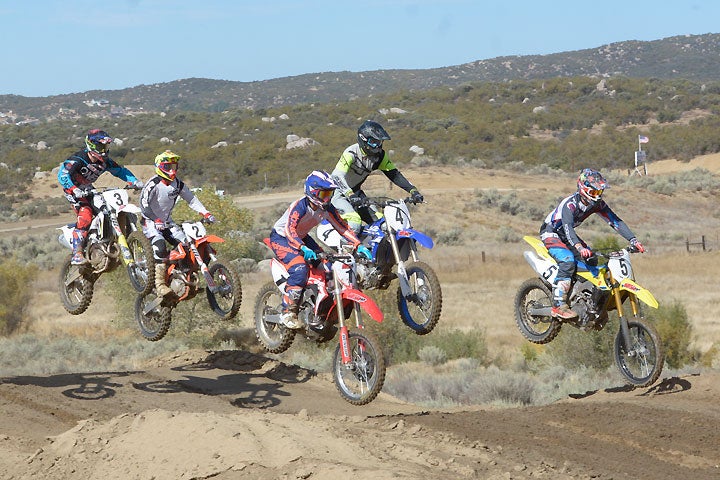
But that doesn’t mean the manufacturers ever stop trying to build the perfect beast. Depending on where they are in their development cycle, the OEMs will either tweak their existing machines or flat-out toss them and start over in an effort to claim the top rung on the 450cc motocross ladder. It’s an ongoing, repetitive process, and 2018 was no different. Hot on the heels of Honda’s surprise upset victory in our 2017 450cc Motocross Shootout with its all-new 2017 Honda CRF450R, two other manufacturers—Suzuki and Yamaha–have stepped up with new designs for the 2018 model year.
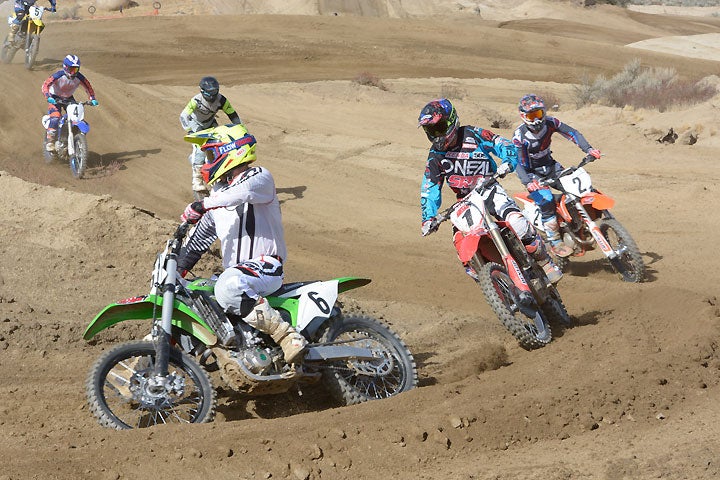
So, before we jump into this year’s shootout, let’s review our 2017 450cc motocross shootout results and recall why the 2017 Honda CRF450R, 2017 KTM 450 SX-F Factory Edition, 2017 Husqvarna FC 450, 2017 Yamaha YZ450F, 2017 Suzuki RM-Z450 and 2017 Kawasaki KX450F finished first through sixth respectively last year.
2017 Honda CRF450R
Why it won: The 2017 Honda CRF450R blitzed the field with an all-new design punctuated by the most exciting engine performance in years. Honda also gained an edge with an all-new aluminum perimeter chassis that handled great and delivered a much more compliant ride thanks to retuned flex characteristics and a lower center of gravity. On top of that, the CRF450R sported an all-new 49mm Showa coil spring fork and a redesigned Pro-Link rear suspension that sat lower in the frame, and it performed brilliantly.
What it needed for 2018: Finer tuning in the suspension department and electric start as standard equipment. Honda offered electric start on the 2017 model, but it was an expensive option that required a lot of work to install.
What’s new: The 2018 Honda CRF450R now comes standard with electric start, and Honda also fiddled with the chassis flex some more by altering the shape and material thickness of the engine hangers and installing heavier, 5.0 Newton/mm fork springs and a heavier, 56 newton/mm shock spring. Honda also changed the valving at both ends in an effort to deliver the same suspension feel but with a little more hold-up in heavy braking bumps.
2017 KTM 450 SX-F
Why it finished second: Because it was the more expensive Factory Edition and not the standard 450 SX-F.
What it needed for 2018: Seriously, very little. The KTM matched the Honda CRF450R in virtually every category, exhibiting brilliant power, excellent handling and awesome suspension performance from its WP AER 48mm fork and linkage-equipped WP rear suspension. Its steel chassis was unflappable regardless of the terrain. Our only major complaint was that its smallish shift lever sometimes made gear changes a hassle.
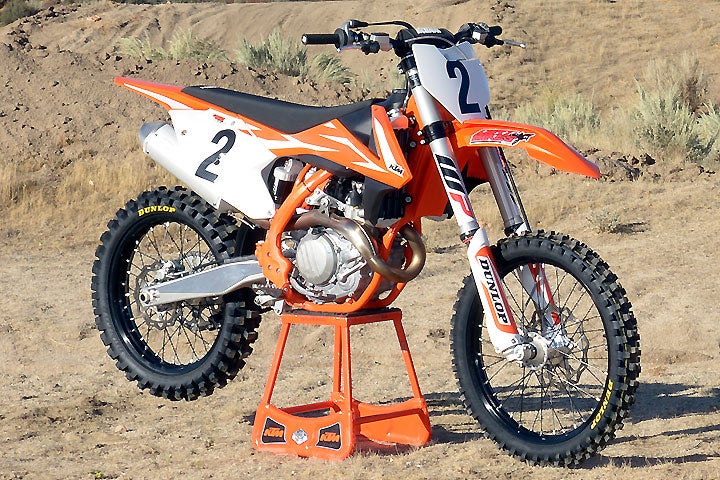
What’s new: Not much. This year’s shootout features the standard model, which brings the MSRP back under 10 grand, and the standard 2018 model gets a much snazzier-looking orange frame. The 450SX-F’s five-speed transmission has been massaged via the change to nitrated steel clutch plates and a new shaft bearing for increased wear resistance. KTM engineers also revised the WP AER fork to make it more compliant by going with a new piston design and air seal design, mitigating what KTM felt was some initial stiction in the fork. The fork was also revalved to give it a more fluid movement through the stroke. The mid-valve piston material is now made of more durable sintered steel instead of composite. The KTM also received a more powerful battery to make its electric starting more reliable.
2017 Husqvarna FC 450
Why it finished third: Because while the FC 450 was solid in every category, it wasn’t outstanding in any of them.
What it needed for 2018: A more robust power feel. The FC 450’s engine is as tractable as they come, but our test crew complained that it simply didn’t feel fast. Since its engine is basically the same design as its sister KTM, the only problem we can see is that its composite subframe carries a different air box design that limits air flow into the engine, giving the Husqvarna a slightly mellower power character. The FC also suffered from the same shifting gripes we had with the 450 SX-F.
What’s new: Pretty much the same things that can be found on the KTM, most notably the revised piston and seal design in the WP AER fork, which was also revalved to give it a suppler feel through the stroke. The mid-valve piston material has also been changed from composite to sintered steel instead of composite.
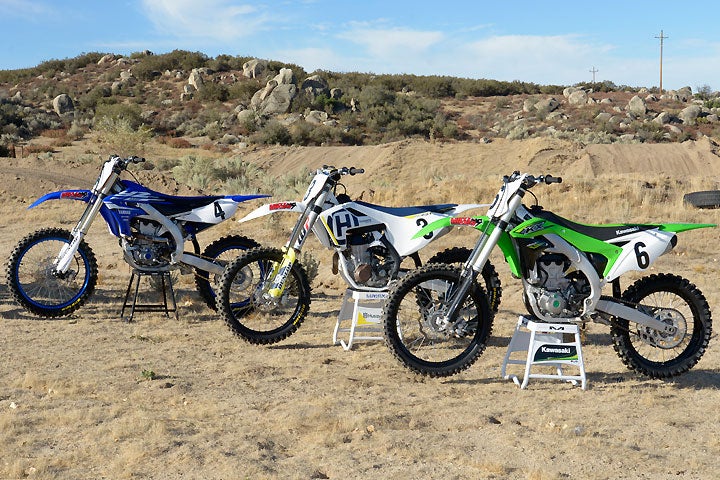
2017 Yamaha YZ450F
Why it finished fourth: After dominating the class for a couple years, the Yamaha’s basic design aged to the point where other machines outshined it.
What it needed for 2018: The one thing it didn’t need was more power or better suspension, as the YZ450F was the brawniest-feeling bike in the class, and its KYB Speed Sensitive System (SSS) fork and KYB shock were the best suspenders in the class. That said, it could feel a bit brutish, and, coupled with a wide-feeling chassis that tended to want to stand up in the corners, the YZ was simply more of a chore to ride fast late in a moto.
What’s new: Everything! Yamaha knew that its existing YZ450F was starting to lose ground in the class, and the tuning fork brand not only came out with an all-new design 2018 YZ450F from stem to stern, it introduced some revolutionary new technology along the way. Starting with an all-new, electric start engine that is tuned to spread the Yamaha’s generous power output farther across the rev range, an all-new bilateral beam chassis that is narrower than the previous version, all-new bodywork and the latest generation of its KYB SSS suspension. Where Yamaha really advanced the YZ450F, however, was in its tuning capability. Yamaha’s Power Tuner iOS and Android app allows the rider to wirelessly tune the engine’s ECU and data log and share a mountain of information with the use of an Apple or Android smartphone.
2017 Suzuki RM-Z450
Why it finished fifth: Because even though we still liked the RM-Z450, we had to face reality. The Suzuki packed a user-friendly engine that simply didn’t have the top-end punch of many of its competitors in a chassis that turns like a corkscrew but is extremely rigid and harsh in the bumps. Suspended up front by a Showa TAC air fork that has arguably never been the best in its class, the RM-Z450 was woefully behind the Honda and Yamaha coil spring forks in overall performance.
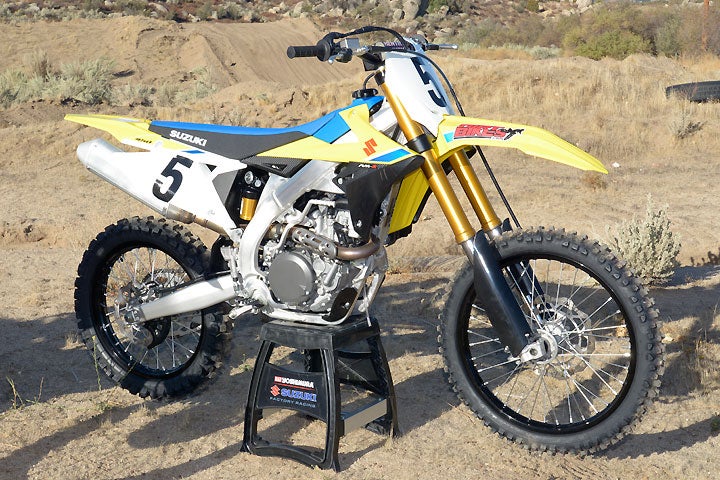
What it needed for 2018: A serious redesign.
What’s new: It’s a serious redesign. Not an all-new one, but significant nonetheless. The 2018 Suzuki RM-Z450’s engine architecture is unchanged from the 2017 model, but Suzuki invested significant R&D into getting it to perform better than the 2017 model by updating the cylinder head and air box for better flow, switching to a more radical intake camshaft profile, combing through the fuel injection to increase power and deliver even better throttle response, and making some minor internal changes, such as changing the piston to increase reliability. Even better news, however, is that the engine is housed in an all-new, twin-spar aluminum chassis that is smaller, lighter and shorter than the 2017 model. Suzuki also ditched the Showa air fork in favor of a new 49mm Showa coil spring fork, and a new Showa BFRC (Balance Free Rear-Cushion) shock absorber now holds up the tail. An oversized 270mm front brake disc has been fitted to make the RM-Z450 more competitive in the braking department, and all-new bodywork also gives the RM-Z450 a much sleeker appearance than the ’17.
2017 Kawasaki KX450F
Why it finished sixth: Because it left too much on the table. The Kawasaki KX450F clearly showed a lot of potential, but it lacked the top-end punch of many of its competitors, and its Showa SFF-Air TAC air fork simply wasn’t to our liking.
What it needed for 2018: Barring a complete redesign, a revamp to the existing engine to increase its top-end charge and a swap to a coil spring fork or—at the very least, to the Showa SFF fork that is found on the Kawasaki KX250F—would have helped the Kawasaki in our opinion.
What’s new: Nothing. Kawasaki obviously spent most of its effort in redesigning the 2018 KX250F. The KX450F will have to wait another day for more love by Kawasaki engineers.
The Call to Cahuilla Creek
Our test crew ventured to Cahuilla Creek MX for our 2018 450cc Motocross Shootout. Cahuilla Creek’s fast, flowing layout and sandy soil was sure to force each manufacturer to prove its horsepower, handling and suspension in the face of its peers. We also weighed and measured each contender and spent a day at Mickey Cohen Motorsports to gather dyno data so we had a clearer picture of our seat-of-the-pants impressions (surprisingly, we found that the dyno tells a very different tale than our butts). Once again, to force the riders to really think through their impressions, we mandated the use of sister publication Motorcycle.com’s comprehensive Scorecard to rank the bikes according to a vast number of categories. The results were interesting, to say the least.
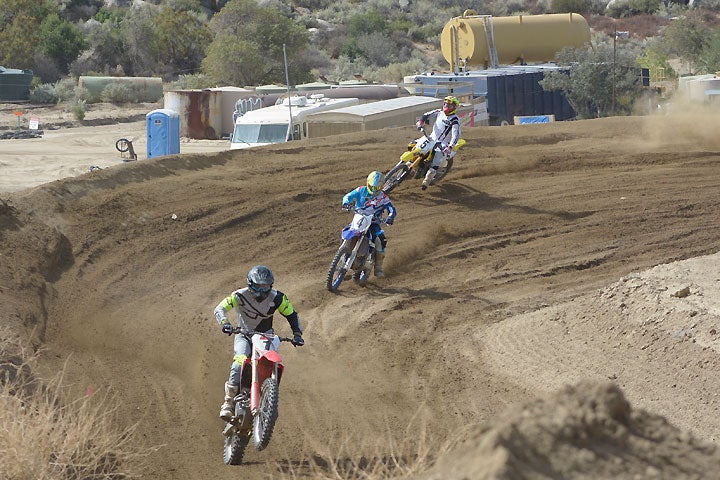
Just like last year, we stuck with five key categories: Engine Performance, Suspension Performance, Handling, Braking Performance and Ergonomics. The MO Scorecard also assigns objective values to such items as price, pounds per horsepower and pounds per lb.-ft. of torque. On the subjective side, a laundry list of additional items such as model features, cool factor and grin factor are all considered when determining the class champion.
 Your Privacy Choices
Your Privacy Choices